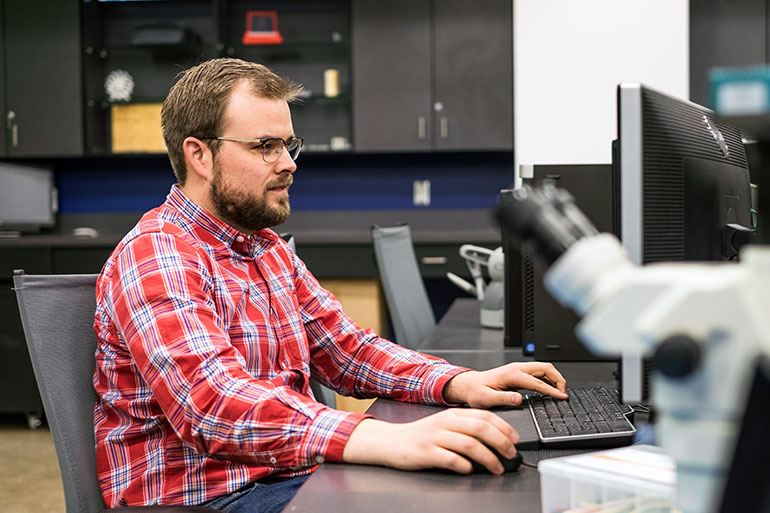
Joshua Brinkerhoff is an assistant professor in the School of Engineering at UBC Okanagan
Simulations help researchers understand how lungs absorb oxygen
Researchers at UBC’s Okanagan campus are using advanced computer simulations to model how air flows into the deepest regions of the lungs and uncover how the early stages of emphysema can impact a patient’s ability to take in oxygen.
The results are significant because clinical studies suggest that identifying emphysema early can significantly improve patient outcomes. Understanding the early stages of the disease will also go a long way towards developing improved surgical or drug treatments.
“Advanced computer modeling has been used for years in areas like commercial aviation or even to predict the weather,” explains Joshua Brinkerhoff, assistant professor in the School of Engineering at UBC Okanagan. “Now, rather than modeling how air swirls in a hurricane, we’re using similar techniques to predict how air moves in human lungs.”
Brinkeroff says this research—which was done in collaboration with colleagues at McMaster University and the Centre for Heart and Lung Innovation at Vancouver’s St. Paul’s Hospital—is still in its infancy but he’s optimistic that it could lead to a better understanding of the development of emphysema and other lung diseases.
Despite advanced diagnostic tools, Brinkeroff says doctors are still challenged with accurately pinpointing emphysema indicators early in patients. Emphysema is a component of chronic obstructive pulmonary disease (COPD) and is typically associated with smoking.
As emphysema in a patient advances, the tissues supporting air sacs inside the lung become damaged, making it harder for patients to exhale. In addition, the tissues between alveoli are gradually destroyed, meaning there are fewer sites for oxygen to be absorbed and patients feel short of breath.
“Prior to this study, we knew that emphysema involved these two mechanisms,” says Dragos Vasilescu, a researcher at the Centre for Heart and Lung Innovation and co-author of the paper. “What we didn’t understand is which is more important in the beginning stages of the disease. These computer simulations help fill in those gaps.”
But according to Brinkerhoff, they’ve only begun to scratch the surface.
“We’ve made the first step of determining a benchmark for airflow in one section of the lungs and the next step will be to create a more detailed analysis of airflow throughout the rest of the lungs. There’s still a great deal that these models can teach and hopefully those insights will one day help patients breathe a sigh of relief.”
The research was published in the Journal of Biomechanical Engineering with financial support from the Natural Sciences and Engineering Research Council of Canada (NSERC).
About UBC's Okanagan campus
UBC’s Okanagan campus is an innovative hub for research and learning in the heart of British Columbia’s stunning Okanagan Valley. Ranked among the top 20 public universities in the world, UBC is home to bold thinking and discoveries that make a difference. Established in 2005, the Okanagan campus combines a globally recognized UBC education with a tight-knit and entrepreneurial community that welcomes students and faculty from around the world. For more visit ok.ubc.ca.
 BC firm's materials in space
BC firm's materials in space $10K discrimination ruling
$10K discrimination ruling Quesnel pulp mill sold
Quesnel pulp mill sold Trudeau in Saskatoon
Trudeau in Saskatoon  Doctors protest tax change
Doctors protest tax change Caribou herds growing
Caribou herds growing  Mistrial in migrant shooting
Mistrial in migrant shooting Military helicopters collide
Military helicopters collide  EU aide accused of spying
EU aide accused of spying  Tourism operators struggle
Tourism operators struggle  Nude Beverages sells line
Nude Beverages sells line Wealth gap widening
Wealth gap widening Leafs even series
Leafs even series Cristall gets pro look
Cristall gets pro look Warriors even series in OT
Warriors even series in OT Swift breaks Spotify record
Swift breaks Spotify record Cudi Coachella set cut short
Cudi Coachella set cut short Bon Jovi 'hasn't been a saint'
Bon Jovi 'hasn't been a saint'



